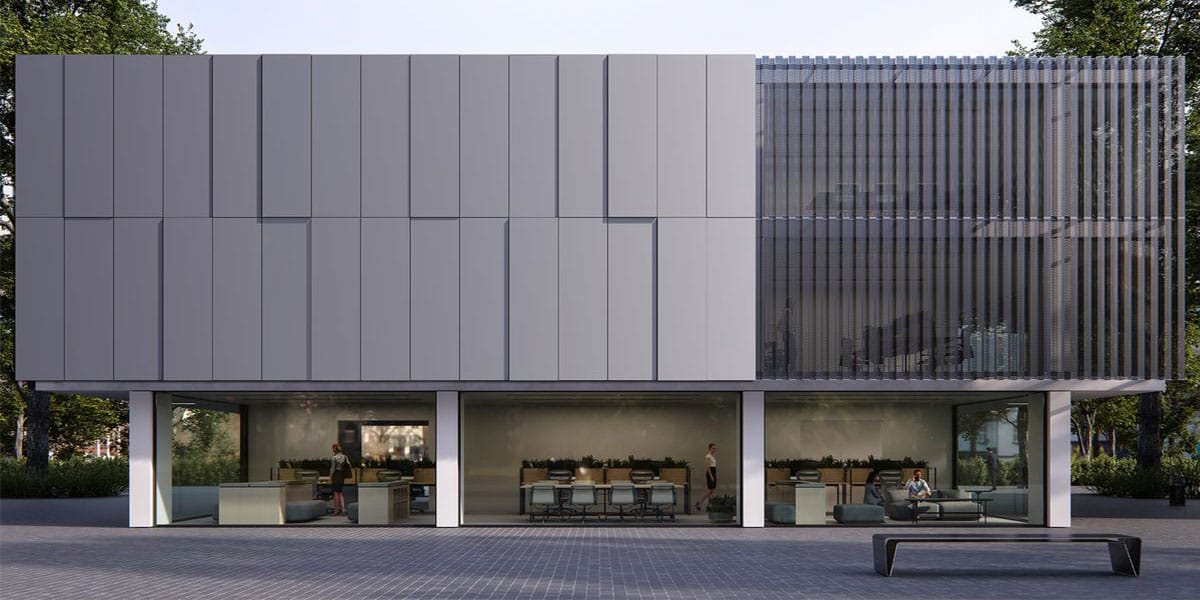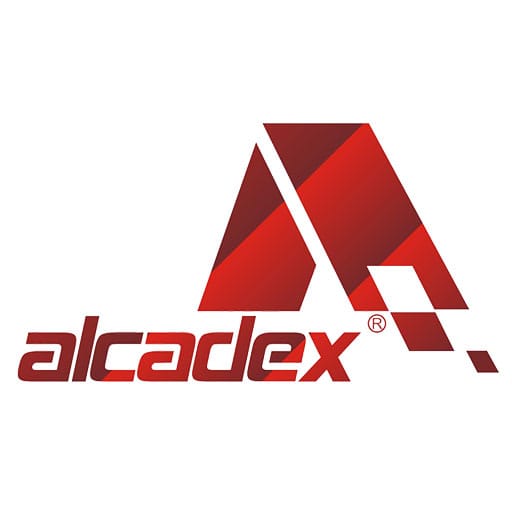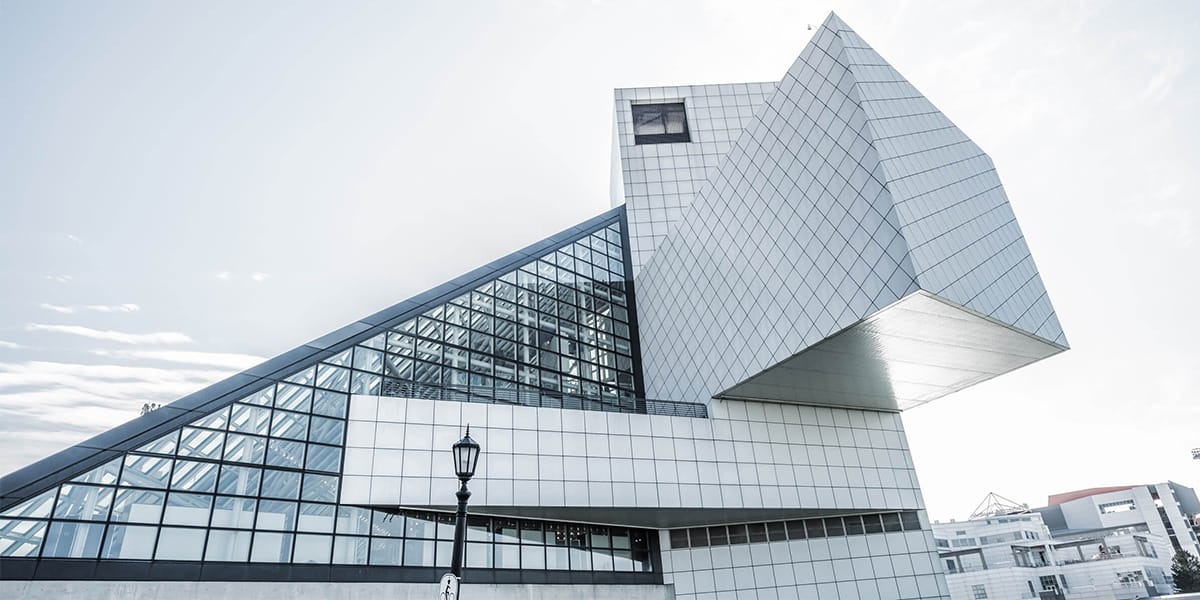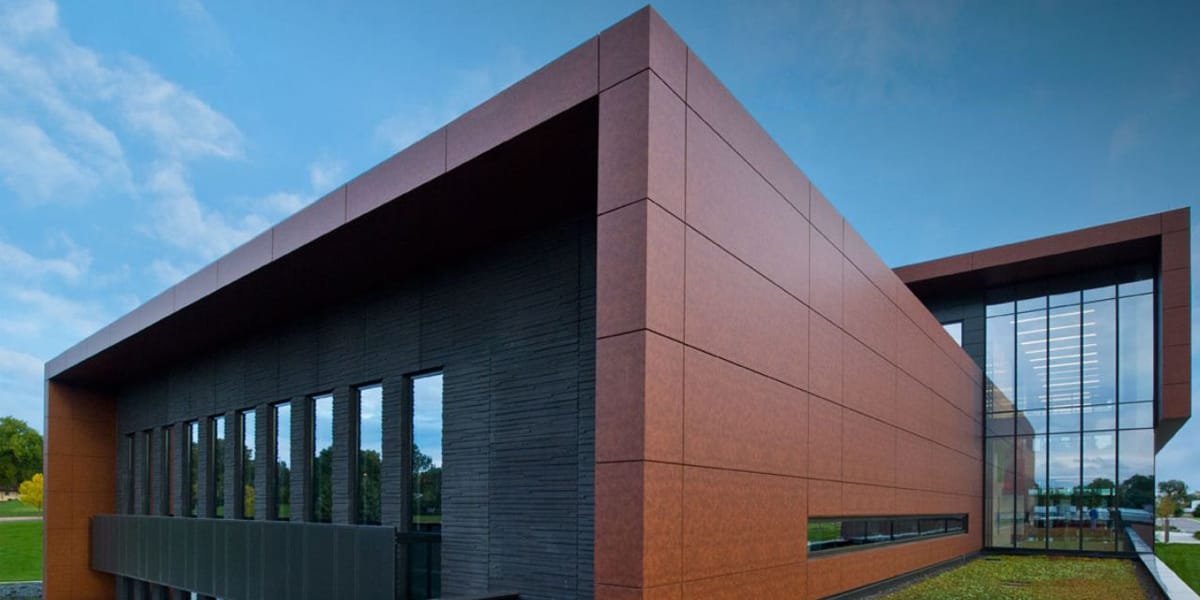
29 Aug Everything You Need to Know About ACP Panels in 2025
Table of Contents
An acp panel is also called an aluminum composite panel. It has a sandwich-like structure. Makers stick two thin aluminum sheets to a middle core. The core is not made of aluminum. It can be polyethylene or a fire-resistant mineral. This special design makes the panel light, strong, and bendable. In 2025, more builders use acp panels. This is because building rules are stricter. People also want more design choices and care about the environment. New materials now include eco-friendly resins. There are also better fire-retardant cores and self-cleaning coatings. Architects and builders worry most about fire safety. They also care about following rules, panel quality, and needing skilled workers to install them.
Key Takeaways
ACP panels are light, strong, and bend easily. This makes them simple to put up. They are great for new building styles. Fire safety is very important. Fire-retardant cores with minerals help keep people safe. They also follow strict building rules. Good coatings like PVDF protect the panels from weather. They stop fading and damage. This helps the panels last 20 years or more. ACP panels work in many ways. People use them for building fronts, signs, inside walls, and ceilings. They are tough and can be used in many designs. Picking the right ACP panel means checking fire ratings, finishes, and certifications. You should also look for eco-friendly features to match your project.
ACP Panel Composition
Aluminum Layers
Aluminum composite panels have two thin aluminum sheets outside. These sheets make the panel strong and protect the core. The thickness of the sheets changes for different uses. Thicker aluminum is used for outside walls or tall buildings. This helps the panel stand up to wind and last longer. Thinner aluminum is used for signs or inside spaces.
Aluminum Coil Thickness (mm) | Aluminum Grade | Application Area | |
|---|---|---|---|
3 mm | 0.12 – 0.3 | AL-312, AL-32, AL-33, AL-33D (AA3105) | Interior, Exterior, Signage |
4 mm | 0.25 – 0.5 | AL-43, AL-45 | Exterior |
6 mm | 0.25 | AL-63 | Exterior & Interior |
High-grade aluminum, like the 3333 or 5333 series, stops rust and makes the panel stronger. These features help the panel last longer in bad weather. The grade and thickness of aluminum change how stiff and tough the panel is. Builders pick special alloys for curtain walls to meet safety rules.
Note: Using thicker aluminum and better alloys makes acp panels safer for tall buildings.
Core Materials
The core is between the two aluminum sheets. It is important for fire safety, weight, and insulation. Makers pick different core materials for different projects.
Description | Fire-Retardant Properties | |
|---|---|---|
Polyethylene (PE) Core | Lightweight, affordable, commonly used for signage and interior applications | Highly flammable, low fire resistance, suitable where fire rating is less critical |
Fire Retardant (FR) Core | Contains additives like magnesium or aluminum hydroxide to reduce flammability and smoke emission | Improved fire resistance, meets stricter fire safety requirements, used in hospitals and high-rise buildings |
Mineral Core | Composed of non-combustible minerals such as magnesium oxide or aluminum hydroxide | Superior fire resistance and thermal insulation, ideal for high-fire-rated applications like airports and tunnels |
Aluminum Honeycomb Core | Hexagonal aluminum foil cells bonded together, includes non-combustible minerals | High fire rating and mechanical strength, suitable for marine, aerospace, and transportation industries |
Polystyrene (PS) Core | Expanded polystyrene foam core providing insulation | Less focused on fire resistance, mainly used for insulation purposes like sound barriers and cold rooms |
New fire-retardant cores use more minerals and less polyethylene. This makes them safer from fire. Some panels now use solid aluminum or honeycomb cores for even better fire safety. Fire-retardant aluminum composite panels are popular in hospitals, hotels, and metro stations. They stop fire from spreading and stand up to bad weather.
Coating and Finish
The coating on an aluminum composite panel keeps it safe from weather and looking nice. Makers use different coatings for different places.
Weather Resistance | Typical Use | Shelf Life | Fade Resistance | Cost | |
|---|---|---|---|---|---|
PE (Polyethylene) | Average; suitable for interior or short-term outdoor use; easily eroded by UV and rain | Interior decoration or short-term outdoor | 5-8 years | Light colors fade in 5-8 years; dark colors fade faster | Lower cost; cost-effective for limited budgets |
PVDF (Polyvinylidene Fluoride) | Superior anti-corrosion and anti-fading; ideal for long-term outdoor exposure | Long-term outdoor use | 15-20 years (less near sea or extreme UV) | Light colors last 15-20 years; dark colors fade gradually | Higher cost; more cost-effective long-term |
The coil coating process has steps like cleaning, priming, baking, and adding a top layer. This makes the panel strong against weather, rust, sun, and water. PVDF coatings last longer and keep their color better than PE coatings. That is why people use them outside.
ACP panels with good finishes do not fade or get damaged by sun and rain.
Light colors last longer and do not fade as fast as dark ones.
Cleaning with gentle soap keeps the finish nice and helps the panel last.
Sealing the edges keeps water out and stops swelling or peeling.
Taking care of the panels and using the right finish keeps them strong and looking good for years. Good coatings mean less work to keep them up and make them last longer in all kinds of weather.
ACP Panel Benefits
 Lightweight and Durable
Lightweight and Durable
Builders like acp panels because they are light and strong. These panels do not make buildings heavy. This helps workers put them up quickly. It also saves money on building costs. Architects can use acp panels to make cool building designs. They do not have to worry about safety. ACP panels weigh less than wood or vinyl. They are also lighter than fiber cement. This makes them cheaper to move and easier to carry.
Benefit | Explanation |
|---|---|
High strength-to-weight ratio eases structural load and installation. | |
Resistant to weathering, corrosion, and UV rays, ensuring long lifespan. | |
Cost-Effectiveness | Affordable upfront cost and long-term savings due to durability and low maintenance. |
Acp panels work well inside and outside buildings. They last a long time. Buildings look good and stay strong for many years.
Weather and Impact Resistance
Acp panels are tough against weather and damage. Tests show they do not fade in the sun. They can handle hot and cold temperatures. Chemicals do not hurt their color or shine. ACP panels can take hits without breaking or peeling. They pass tests for bending and peeling. This means they are flexible and strong.
Tip: ACP panels keep working well outside for a long time, even in bad weather.
Panels do not change after sitting in acid or alkali for a day.
Their coating stays good in very hot and cold cycles.
Tests show acp panels can stand strong winds up to 17 m/s. This makes them good for tall buildings.
Acp panels are a smart pick for places with tough weather or lots of use.
Maintenance and Longevity
Acp panels last a long time and need little care. Most panels work for 30 to 50 years if installed right. Aluminum makes a shield that stops rust. This helps panels last longer. PVDF coatings help panels last 15 to 20 years or more. They do not need much cleaning.
ACP panels without special coatings last about 10 years.
Cleaning and sealing the edges keeps panels looking nice.
How long panels last depends on their quality and thickness. It also depends on how they are put up and the weather.
Acp panels are a good choice for new buildings. They are light, strong, and last a long time. They help builders make safe and green buildings.
Types of ACP Panels
There are different kinds of aluminum composite panels. Each kind is made for a special use. Builders and architects need to know the types. This helps them pick the best panel for their job.
Standard ACP Panels
Standard acp panels have a core made of polyethylene. Two aluminum sheets cover the core. These panels are light and simple to use. Builders use them for short buildings, inside walls, and signs. They give some fire safety but not enough for strict rules. Most of the time, they protect well from weather and last long.
Standard ACP | |
|---|---|
Core Material | Polyethylene core |
Fire Resistance | Basic, not specialized |
Surface Finish | Standard aluminum finish |
Application Focus | Lightweight, durable, easy fabrication |
Note: Standard acp panels are good when fire safety is not the main need.
Fire-Retardant ACP Panels
Fire-retardant acp panels have a core with special minerals. These minerals help stop fires. The panels follow important safety rules like NFPA 285 and EN 13501-1. They do not catch fire easily. If the fire stops, the panels stop burning too. In 2025, these panels must have at least 70% non-burnable stuff in the core. Other groups check the panels to make sure they are safe. Builders use these panels in hospitals, schools, airports, and tall buildings.
Feature Category | Fire-Retardant ACP |
|---|---|
Core Material | Fire-resistant minerals (e.g., alumina trihydrate) |
Fire Resistance | Enhanced, meets strict codes (NFPA 285, EN 13501-1) |
Surface Finish | Standard or fire-retardant coatings |
Application Focus | Safety-critical, fire compliance |
Tip: Always look for safety labels and test papers before picking fire-retardant acp panels.
Decorative and Foam Core Panels
Decorative acp panels are made to look nice. They come in many colors and styles. Some look like metal, wood, or mirrors. The core can be standard or fire-retardant. It depends on what the project needs. These panels help make buildings look special and pretty. Foam core panels use a light foam in the middle. This gives extra insulation. These panels are good for inside spaces, stores, and fun signs.
Feature Category | Decorative ACP |
|---|---|
Core Material | Standard or fire-retardant, focus on finish |
Fire Resistance | Depends on core type |
Surface Finish | Metallic, wood grain, mirror, custom designs |
Application Focus | Aesthetic enhancement, design flexibility |
Decorative acp panels let designers match any look or brand they want.
Applications of ACP Panels
 Building Facades
Building Facades
Architects often pick acp panels for building facades. These panels protect buildings from bad weather. They keep their color for up to 20 years. Curtain walls with acp panels block wind, rain, and sun. Ventilated cladding systems use acp to save energy and keep buildings warm or cool. Builders use acp for balconies, wrapping columns, and fixing old buildings. The panels help buildings meet green rules and get LEED points. Because acp panels are light, workers build faster and spend less money. ACP panels are safer in fires than PVC. They last longer and let designers try more styles. That is why many people use them for outside walls in new buildings.
ACP panels give:
Color and finish that lasts a long time
Strong shield from weather
Energy savings for buildings
Signage and Interior Decoration
Acp panels are great for signs and inside decoration. Designers use them for walls, room dividers, and cool displays. The panels come in lots of colors, textures, and finishes. This helps architects match any style they want. ACP panels are also used in furniture and stores. Their smooth surface is good for printing signs and logos. They are quick to put up, so projects finish on time. ACP panels do not break or stain easily. This makes them good for busy places.
Tip: ACP panels help make modern, eye-catching rooms and signs.
Ceilings and Other Uses
Ceilings with acp panels look neat and new. The panels hide wires and pipes in lobbies, offices, and airports. ACP panels are also found in elevators, canopies, and even vehicles. They work well both inside and outside. ACP panels are better than PVC outside because they do not fade, rust, or burn easily. This makes them a smart pick for tough places.
Application Area | ACP Panel Advantage |
|---|---|
Ceilings | Light and easy to put up |
Canopies | Tough against weather and hits |
Elevators | Strong and look modern |
Acp panels have many uses in building. They last long, look nice, and help keep people safe. This makes them important for new buildings and fixing old ones.
ACP Panel Installation
Modern Installation Methods
Today, workers use computers to help plan acp panel jobs. BIM lets teams see the whole project before they start. This helps them make fewer mistakes and finish faster. Installers must follow the maker’s rules and use fire-rated panels on tall buildings. Safety is very important. Teams wear safety gear and use the right tools to cut and attach panels. They clean and level the area before starting. Workers measure and cut each panel carefully. This makes sure the joints look smooth. They use special glue or fasteners to put up the panels. All the edges get sealed to keep water out. Teams check their work often to keep panels straight and tight.
Tip: Good planning and using the right tools help workers install acp panels quickly and safely.
Cost and Time Factors
In 2025, putting up acp panels costs about $430 to $592 for each square meter. This price covers both the panels and the work to install them. The usual cost is about $511 per square meter. The price can change if labor is more expensive, the building is bigger, or the job is in a different place. ACP panels are light and easy to move. This means workers finish faster and the job costs less than stone or fiber cement. The panels bend easily, so workers can make cool shapes and designs. Lighter panels also cost less to ship. All these things make acp panels a smart pick for quick and easy building.
Material | Average Installation Time | Labor Intensity | Cost per m² (2025) |
|---|---|---|---|
ACP Panels | Fast | Low | $511 |
Stone Cladding | Slow | High | Higher |
Fiber Cement | Moderate | Moderate | Moderate |
Quality Control
Quality checks help acp panels last longer and work well. Teams use tools to keep panels straight and lined up. They look for any damage before they start. Fasteners must be spaced right and put in tight. Workers seal the joints with weatherproof stuff to stop leaks. There must be good airflow and drainage behind the panels. This keeps water from building up. Expansion joints let the panels move when it gets hot or cold. Some jobs need fire-rated panels and barriers to meet safety rules. Teams check the panels often and fix problems to keep them safe and looking good for a long time.
Get surfaces ready and look for damage.
Use the right fasteners and sealants.
Check that panels are lined up during the job.
Make sure there is airflow and drainage behind panels.
Follow fire safety rules for every project.
Choosing ACP Panels
 Selection Factors
Selection Factors
Picking the right ACP panel means thinking about many things.
The finish matters. Wood finishes can be light or dark. They help match different styles and uses.
Eco-friendly panels are better for the planet. They help buildings get green awards.
ACP panels work for outside walls, inside rooms, furniture, and signs.
There are different ways to put up panels. Hanging, dry gasket, or wet sealant systems fit different jobs.
Cleaning panels with gentle soap keeps them looking new. Do not use strong cleaners. Check panels often to help them last longer.
A project manager should also think about:
If panels can stop fire, which is important for tall or special buildings.
How easy it is to put up panels. Some have clips or can bend to fit.
The color and finish, like shiny, flat, or brushed, to match the look you want.
What the panels will do, like protect, decorate, or both.
How much care and money the panels need over time. Spending more at first can save money later.
If the panels use recycled stuff or are made in a way that is good for the earth.
Learning about new trends, like smart panels or custom looks.
Note: The quality, thickness, coating, and warranty all help you pick the best acp panel for your job.
Comparing Types and Certifications
Certifications help people pick safe and good ACP panels. Makers who follow ISO rules show they make quality products. Fire safety labels, like ASTM E84 Class A, mean panels are safe for big buildings. Green labels, like LEED, show panels are good for the earth. These labels mean panels save energy and help the planet. Always look for labels from trusted groups to make sure panels are safe and follow the rules.
Certification Type | What It Proves | Why It Matters |
|---|---|---|
ISO | Quality and regulatory compliance | Reliable product performance |
ASTM E84 Class A | Fire resistance | Safety in commercial projects |
LEED | Sustainability and eco-friendliness | Green building points |
Tips for Value
To get the best deal on ACP panels, buyers should:
Pick brands that are known for being strong and lasting a long time.
Know how finishes, like PVDF, change how panels look and last.
Make panels fit the special needs of each job.
Buy lots of panels at once to save money.
Choose finishes and cores that look good and fit the budget.
Tip: Buying ACP panels from top makers can save money and give you better features, so you get good quality without spending too much.
ACP panels are good at standing up to bad weather. They help save energy and let builders try many designs. In 2025, new cores and smart coatings make them safer from fire. These changes also help the panels last longer and be better for the earth. People who buy panels should check fire ratings, finishes, and safety labels. This helps them pick what fits their project best.
Pick panels that do not rust or get damaged by weather.
Try to find panels that are safe for the earth and have special coatings.
If you want the best panel for your job, talk to experts or trusted makers. They can help you choose the right one for what you need.
FAQ
What is the main advantage of using ACP panels in construction?
ACP panels are light but also very strong. Builders can put them up fast. These panels do not get damaged by weather or hits. Architects like them for new building styles and saving energy.
Are ACP panels safe for high-rise buildings?
Yes, they are safe if they are fire-retardant. Makers use mineral cores to stop fires from spreading. Builders pick certified panels for hospitals, schools, and tall buildings.
How long do ACP panels last outdoors?
Most ACP panels last outside for 15 to 20 years. PVDF coatings help them keep their color and fight bad weather. Cleaning them and putting them up right helps them last longer.
Can ACP panels be recycled?
Yes, you can recycle the aluminum in ACP panels. Many makers use recycled materials to make new panels. Picking eco-friendly panels helps green building projects.



 Lightweight and Durable
Lightweight and Durable Building Facades
Building Facades Selection Factors
Selection Factors